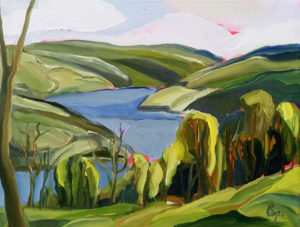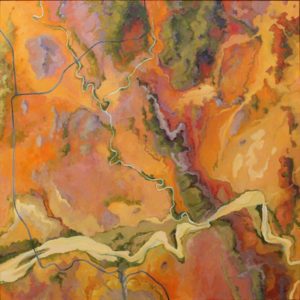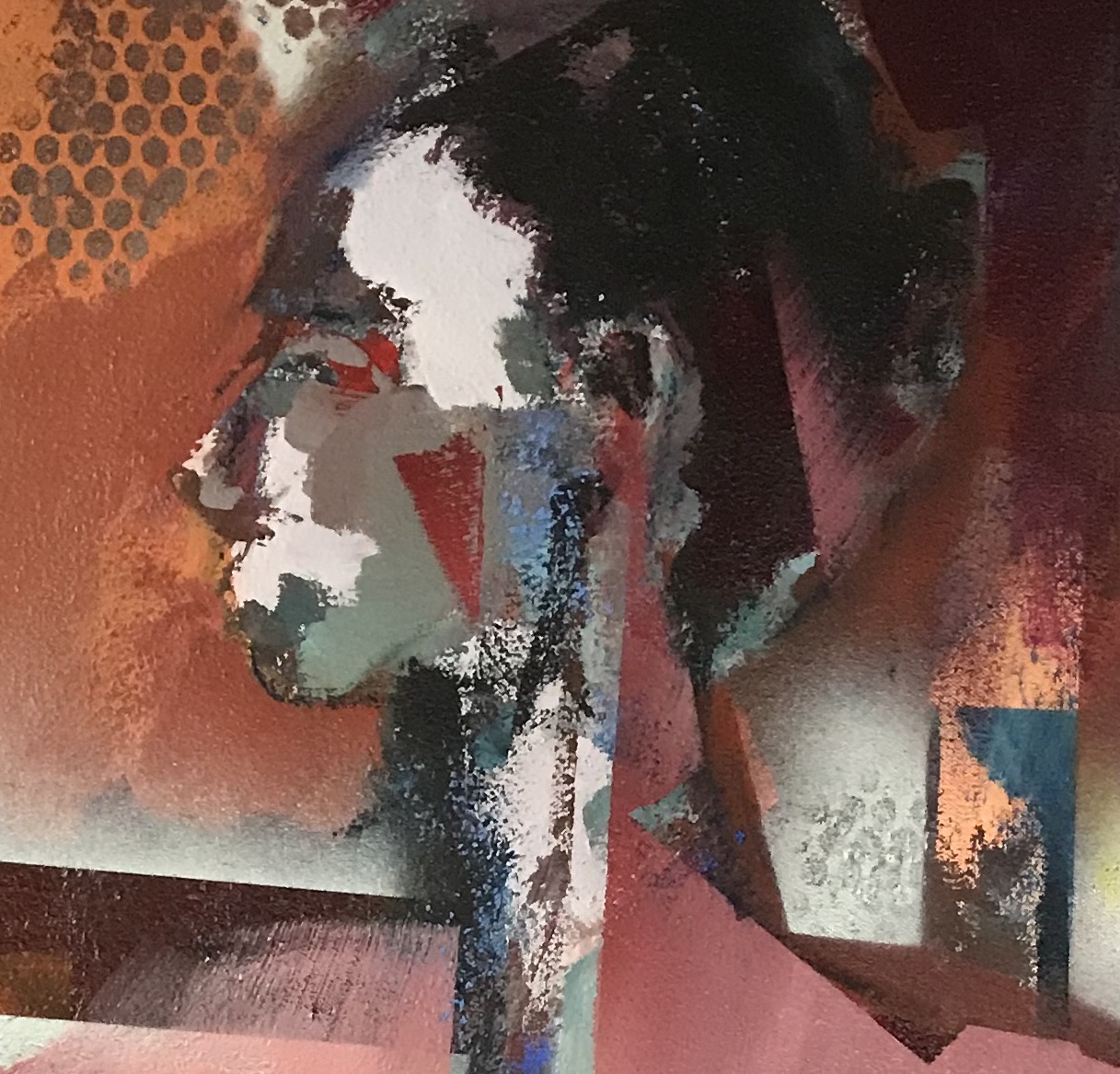Transformations at Oxford
At Oxford Gallery, “Transformation” offers new work from three artists who are finding different ways to split the difference between representation and abstraction.

Keuka Bluff, Phyllis Bryce Ely
In my favorite work from Phyllis Bryce Ely, the forms emerge under curls of heavy paint shaped like solidified candle smoke. Lately, and maybe for longer than I’m aware, she’s been laying down an undercoat of bright reddish-orange, as a ground, and then painting in tones complementary to that first coat, letting it peek through here and there the way Thiebaud does, suggesting a field of energy behind the visible. There’s little in the formal qualities of her work that reminds me of Burchfield, except maybe the ghostly way he evoked clouds at night, but her images have a similar numinous quality. Jim Hall’s comparison to the Group of Seven is apt. In her work, there’s more than an echo of Lawren Harris’s glowing landscapes under cold Northern light.

Desert Solitaire 18, Barbara Page
In her aerial views of cultivated land, Barbara Page offers striking abstractions that allow her to improvise with rich, lush color. In Desert Solitaire 18, the course of creeks and rivers rend the image, this way and that, like slow squirming bolts of lightning. Those sinuous lines of pale blue or green or cream break up areas of tilled earth she pushed up the spectrum into red and orange. Like the carefully rendered watershed, the topographical meanderings of edges between woods and field serve as backdrop for boundaries, just as serpentine. And then a blue line, a highway maybe, moves up the canvas, forking into a pair before heading off the edge, suspended over all of it like a line in the sky. As Jim Hall points out on the gallery’s site:
Page came to national prominence with “Rock of Ages, Sands of Time,” an installation consisting of 544 square panels, each panel representing one million years of the history of the earth. The installation formed the centerpiece of the Museum of the Earth, which opened in 2003 outside Ithaca, NY. With uncanny consistency, each panel reads as both a representation of a fossilized remains and as a painterly abstraction, and our fascination resides in its assuming a dual role as object of scientific interest and object of beauty. This project was followed by a similar installation of 268 porcelain tiles lining a pedestrian bridge at the North Carolina Museum of Natural Sciences.
In A.J. Dungan’s recent work, he seems to be pushing toward flatter images—in his last show, some of his figures seemed bulkier, like Bacon’s, where the energy of his brushwork supplemented the sense of depth. Here, many of the paintings look even more Cubist. He uses what appears to be a honeycomb stencil sprayed onto areas that create an even flatter aspect to things, and his figures are more distorted than I recall from the earlier work. When it all comes together, he achieves a sense of timelessness: in The Eunuch’s Wife, he takes a nude and abstracts it into an intersection of masked off areas in the torso, less suggestive of her natural shapes than some of his past interpretations. The image is mostly flesh-toned in the figure shifting to bronze in the background, with areas of honeycomb patterns, sprayed through stencils that look like from furnace filter screens or maybe bubble wrap. It’s like a bit of a loan of Pop art Ben-Day dots inside an image that has much more in common with AbEx and cubism. In Dungan’s work, it seems less linked to Lichtenstein and more to Braque’s ability to suggest wood grain and wallpaper patterns, bringing what’s depicted up to the painted surface. But—as in many paintings—he concentrates most of the image’s energy in a tight, small area, in this case her face. The face is where, in this painting, he really hits his stride: the image looks as if it’s almost a collage of shredded and sliced fabric or paper, yet the assembly of forms work perfectly to suggest a three dimensional face, with areas of pure white to indicate a profile half in and half out of the light. The eye is hardly indicated and yet looks exactly right, the tiny highlight somehow conveying a thousand-yard stare of someone alone and thinking of other times, other places.
Dungan has been studying Matisse, Picasso and Braque. I asked if he was doing what Braque did, mixing sand into his paint, to get the texture in some of his work. In a note he said, “The show spans a time of about 12 months work. I work full time at my day job so it’s always a balancing act between work and studio. It helps that I am a commercial printing image-color specialist so it’s more like one long day job between the art and work. (Some of the texture) is a combination of gesso and paint applied with a nap roller. I did try sand at one point and it was too aggressive for my paint application. I have also expanded my technique and process for all these paintings adding acrylic spray paint, pastel, masking and brush work in layers.”
The show runs through Nov. 24.

Comments are currently closed.